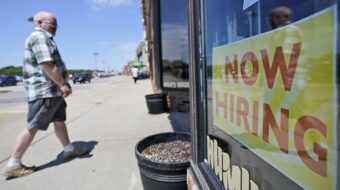CHICAGO – Mayor Richard M. Daley announced a new 10-year Plan to End Homelessness. The plan “focuses on moving the homeless into permanent housing as rapidly as possible, and providing additional social services to help resolve the problems that caused them to lose their homes” according to a Jan. 21 press release.
Daley said the 6,200 shelter beds have served Chicago well and “No one has to sleep on the streets in the city of Chicago.”
But a local homeless man on the city’s Southside told the World that when he has enough money he pays people to give him a place to stay “but can’t really get into a shelter” on most nights. Most of the money he has comes from cleaning car windows, which in winter is especially dangerous, and pointed to a large piece of frost bite on his cracked hands to prove it.
Daley’s plan is similar to a recent report released by National Alliance to End Homelessness (NAEH), “How to End Homelessness in Ten Years.” The report focuses on the need to drastically increase the supply of affordable housing and livable wages as the primary cure to the unrelenting short-term homeless population and poverty. The report also strongly advocates the need for a widescale social support network for people who need mental or physical assistance.
Nationally, close to a million people are homeless each night. Figures for Chicago are not estimated by the city, although agencies like the United Way say that numbers reach up to 15,000 people a night here.
On its face Daley’s response to the rapid growth of homelessness in his tenure is appropriate. He wants to increase the availability of permanent housing by using the money spent of temporary shelters, saying it cost $1,200 a month to support a family of three in a shelter but it would be less for permanent housing with continued services. However, to date he only plans the creation of 90 additional family units, far short of the thousands of units activist say are needed.
In recent months Daley has been under attack due to his administration demolition of most public housing complexes, which have forced thousands of people to search for housing during one of Chicago’s worst winters in an already tight affordable housing markets.
The city’s plan advocates subsidized mortgages and rental units while unemployed breadwinners look for new jobs. But the plan does not include any mass job creation program.
Daley indicated that he may, in addition to the 90 family units, build 500 more Single Room Occupancy (SRO) units. But it all depends on federal and state monies.
In May of 2002, Daley released a five-year plan that also planned for the same 90 family units and the 500 SRO units. None of those projects have been started.
This reporter telephoned city officials to question them about these policies, but the calls went unanswered.
Daley has also been under fire for the mass gentrification of many Chicago neighborhoods, which have left many communities with empty condos that residents cannot afford.
Protests and rallies are planned to bring attention to the growing housing crises.
The author can be reached at bkishner@pww.org











Comments